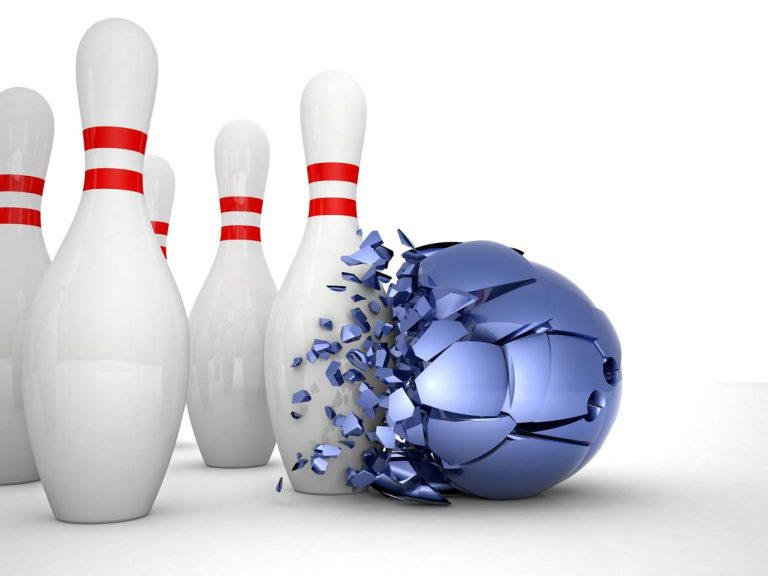What is 5 Pin Bowling? Canada’s Favorite Bowling Version
5 pin bowling is a variation of the traditional bowling game that originated in Canada. Created by Thomas F. Ryan at his Toronto Bowling Club in 1909, it offers a unique twist on the standard 10-pin game that most people are familiar with. The game was designed to be faster and more accessible, catering to bowlers who wanted a more dynamic and less physically demanding sport.
The basic objective in 5 pin bowling is similar to the traditional game—players roll a bowling ball down a wooden or synthetic lane to knock down pins for points. However, in 5 pin bowling, there are only five pins arranged in a V-shape, and the balls used are smaller, without finger holes, making them easier to handle.
This allows players of all ages and physical abilities to enjoy the sport. The scoring system is also different, with varying point values assigned to each pin, which adds a strategic component to the game.
In the gameplay of 5 pin bowling, players must adhere to a set of rules and regulations that govern the sport. Over the years, the game has developed its own cultural and historical significance in Canada.
Key Takeaways
- 5 pin bowling is a Canadian innovation that offers a more accessible alternative to traditional 10-pin bowling.
- The game features unique rules and a distinctive scoring system which emphasizes strategic play.
- It holds both recreational and competitive significance, with strategies and techniques enhancing its complexity.
Basics of Five Pin Bowling
In five pin bowling, your main objective is to knock down pins arranged in a V-formation for points. You will use hand-sized hard rubber balls and adapt your bowling skill to a smaller scale.
Objective and Gameplay
Your goal in five pin bowling is to knock down all five pins placed at the end of the bowling lane in a V shape. Each of these pins has a different point value, with the center pin, known as the headpin, being of the highest value. In this game, the bowler is allowed to roll the ball three times per frame. Unlike the traditional ten-pin bowling, the balls used in five pin bowling have no finger holes.
Scoring Basics
Scoring in five pin bowling is unique with points assigned as follows:
| Pin Position | Point Value |
|---|---|
| Headpin (center) | 5 |
| Pins on either side of headpin | 3 |
| Outermost pins | 2 |
Each pin knocked down counts toward your score of that particular frame. If you knock down all pins with one ball, it is called a “strike,” registering 15 points plus the points from the next two ball throws. A “spare” is when you knock down all pins with two balls thrown, recording a score of 15 points plus the points from the next ball throw. If pins are left standing after your third ball, you only get the points for the number of pins you knocked down.
Bowling Equipment
The equipment you use in five pin bowling is essential in your experience of the game. The bowling balls are smaller than those in ten-pin bowling and don’t have finger holes, allowing them to fit in the palm of your hand.
The balls are made of hard rubber, and some variants are wrapped in a rubber band to add spin and power. You will encounter five bowling pins in each frame, which are also smaller than ten-pin bowling pins and arranged in a V-formation, requiring precision and skill to proficiently score.
Rules and Regulations
Understanding the rules and regulations of 5 pin bowling ensures a fair and enjoyable game for all players. It’s important to familiarize yourself with the scoring system, what constitutes a foul, and the expected etiquette.
Scoring System
In 5 pin bowling, your score hinges on the number of pins you knock down and the type of frames you roll. A strike is when you knock all five pins down with your first ball, scoring 15 points plus your points for the next two balls.
A spare gets you 15 points plus the points from your next ball. An open frame is when pins remain standing after you’ve used both balls, and you only earn points for knocked-down pins. Your total score for a game could range from zero to a perfect 450, with the average score generally falling much lower than that.
| Frame Type | First Ball | Second Ball | Score Calculation |
|---|---|---|---|
| Strike | 5 pins | N/A | 15 points + points from next two balls |
| Spare | <5 pins | Remaining | 15 points + points from next ball |
| Open Frame | <5 pins | < Remaining | Sum of pins knocked down in both balls |
Fouls and Penalties
You commit a foul if you step over the foul line at the end of the lane when releasing your ball. Each foul incurs a penalty, which typically means the rolls in a frame where a foul occurred are scored as zero, regardless of the actual pins knocked down.
- First ball foul: Frame scored as zero
- Second ball foul: Only points from the first ball are counted
Game Etiquette
Bowling etiquette plays a vital role in five-pin bowling. Always wait for your turn and don’t encroach on adjacent lanes. You should remain behind your fellow bowler while they are preparing and executing their delivery. This not only maintains safety but also ensures a respectful and pleasant environment for all participants.
Advanced Techniques and Strategies
In 5 pin bowling, mastering advanced techniques and refining strategies are essential for consistently high-scoring games. Your focus on delivery, strike and spare conversion, as well as strategic play throughout the 10 frames, will be critical to maximizing your scores.
Perfecting Delivery
To enhance your performance, you must ensure your delivery is both consistent and precise. Consistency in your approach, swing, and release contributes to a repeatable motion that can lead to higher scores. Key elements of a refined delivery include:
- Stable Stance: Begin with a balanced and comfortable starting position.
- Smooth Approach: Your walk-up to the foul line should be slow and controlled.
- Consistent Swing: A fluid arm swing is vital, keeping your hand and wrist straight throughout.
- Precise Release: Aim for a clean release of the ball at the lowest point of your swing to improve accuracy.
Striking and Sparing
Strikes and spares obviously increase your point totals.
- Strikes: Aim between the headpin and the either of the 2 pins directly beside it, depending on your dominant hand, to increase the likelihood of a strike.
- Spare Strategy:
- Single Pin: Align your body with the pin and focus on a direct path.
- Split: For a split, find the optimal angle to hit pins in a way that they deflect into each other.
Maximizing Scores
The final goal is to accumulate the highest score possible, ideally aiming for a perfect game. Here are strategies for maximizing your points:
- Double and Triple: Capitalize on consecutive strikes, known as a “double” or “triple,” for a significant boost in points due to the scoring system’s cumulative nature.
- 10th Frame Strategy: Focus on closing the 10th frame with strikes or a spare followed by a strike for extra shots and a chance at additional points.
- Pin Count: You have 3 throws to knock down 5 pins, meaning you have to hit more than 1 pin with one or more throws.
The Sport’s Cultural and Historical Significance
| Date Event Occurred | Event Description |
|---|---|
| 1909 | Inception of five-pin bowling by Thomas F. Ryan |
| 1960s | Formation of the Canadian 5 Pin Bowlers Association |
Five-pin bowling, a uniquely Canadian take on the traditional sport of bowling, possesses a charming blend of cultural and historical significance largely concentrated within the northern American continent, especially the Canadian region. Created in 1909 by Thomas F. Ryan at the Toronto Bowling Club, it has remained a largely Canadian sport.
It offers a less physically demanding alternative suitable for children and adults alike, and yet it is more challenging than 10-pin bowling.
The Canadian 5 Pin Bowlers Association, founded to govern and promote the sport, evidences the depth of its cultural roots. This organization showcases the sport’s formal establishment and regulation, signifying its prominence as a staple in Canadian leisure activities.
Bowling alleys have historically served as social hubs where people gather, celebrate, and compete. This is no different from the more popular 10-pin version of the sport. Although primarily played in Canada, you can find 5-pin bowling options scattered across the United States, as well.
I recommend that you find a bowling center near you with 5-pin lanes, and give it a try.






